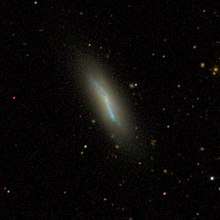NGC 216
NGC 216 is a lenticular galaxy located approximately 68.8 million light-years from the Sun[2] in the constellation Cetus. It was discovered on December 9, 1784 by William Herschel.[3]
| NGC 216 | |
|---|---|
 SDSS image of NGC 216 | |
| Observation data (J2000 epoch) | |
| Constellation | Cetus |
| Right ascension | 00h 41m 27.1s[1] |
| Declination | −21° 02′ 44″[1] |
| Redshift | 0.005150[1] |
| Distance | 68.8 Mly[2] |
| Apparent magnitude (V) | 12.9r[1] |
| Characteristics | |
| Type | S0[1] |
| Apparent size (V) | 2.0' × 0.7'[1] |
| Other designations | |
| ESO 540- G 015, MCG -04-02-035, 2MASX J00412688-2102529, IRAS F00389-2119, ESO-LV 5400150, 6dF J0041268-210253, PGC 2478.[1] | |
See also
References
- "NASA/IPAC Extragalactic Database". Results for NGC 0216. Retrieved 2016-09-02.
- An object's distance from Earth can be determined using Hubble's law: v=Ho is Hubble's constant (70±5 (km/s)/Mpc). The relative uncertainty Δd/d divided by the distance is equal to the sum of the relative uncertainties of the velocity and v=Ho
- "New General Catalog Objects: NGC 200 - 249". Cseligman. Retrieved September 15, 2016.
External links
- NGC 216 on WikiSky: DSS2, SDSS, GALEX, IRAS, Hydrogen α, X-Ray, Astrophoto, Sky Map, Articles and images
- SEDS
This article is issued from Wikipedia. The text is licensed under Creative Commons - Attribution - Sharealike. Additional terms may apply for the media files.